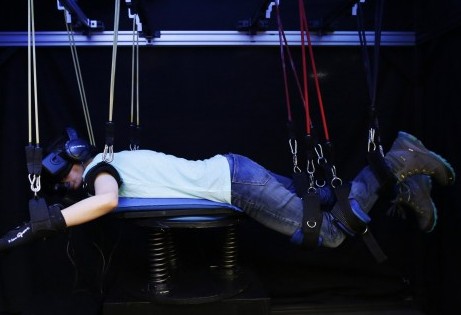Disability-Simulating VR Promotes Empathy
Published April 29, 2016 on MIT Technology Review
Dhruv Jain wants to take you to the bottom of the sea so you can understand his life a little bit better. An avid diver and a graduate student in MIT’s Living Mobile Lab, Jain is the creator of Amphibian—a virtual-reality simulator that immerses users in nearly every aspect of a real scuba dive, except the water.
It may sound as though Jain is simply trying to re-create what it’s like to go diving. After all, his simulator includes an Oculus virtual-reality headset, gesture-recognition gloves, an ottoman-like contraption that you lie on top of, and elastic harnesses that suspend your arms and legs—all to capture the sensation of swimming. But as much as Amphibian focuses on matching that sensory experience, his true goal is actually more complicated. Partially deaf since birth, Jain began diving after coming to MIT and found that being in underwater environments where sound is muted provided a peaceful, almost meditative experience similar to what he feels when he turns off his hearing aids.
“If I close my hearing aid, I feel liberated,” he says. “I wanted people to feel the sensory deprivation that I feel when I close my eyes.”
Numerous virtual-reality and augmented-reality projects aim to give disabled people virtual versions of experiences only the able-bodied can have. But a handful of companies and researchers like Jain are instead focusing on the opposite—using the technology to help the general public understand what it’s like to live with a physical disability or mental illness. For example, the interactive digital marketing company Viscira has deployed programs that mimic the symptoms of schizophrenia and macular degeneration. Excedrin’s “The Migraine Experience” marketing campaign for headache medicine simulates common migraine effects like light sensitivity, vision loss, and disorientation.
In another academic project, Reika Yoshino and Jun Xia, two University of Pennsylvania undergrads, anonymously surveyed 40 students about their experiences with certain mental illnesses and built a virtual environment based on the results. Users are placed on a floating bed (modeled after those in the school’s dorms) in a gray-hued world, surrounded by textbooks and a television flashing the Netflix logo. They can only look—they can’t touch or interact with anything—but they’re encouraged to talk about how the project makes them feel.
“People who had experiences with depression thought it was peaceful,” says Yoshino, adding that people who had not felt depression thought it was lonely and scary.
Virtual projects aimed at cultivating empathy for those with medical conditions have been around since the 1990s, but whether these initiatives permanently change attitudes or behavior is “still unknown,” says Albert “Skip” Rizzo, director for medical virtual reality at the University of Southern California’s Institute for Creative Technologies. That’s partly because until recently, building and studying VR empathy systems has been pricey.
Yet while the efficacy question isn’t conclusively answered, some research suggests that virtual reality can help us think outside ourselves and change our actions accordingly. Participants who experienced a color-blindness simulation, for instance, were more likely to help real color-blind people.Similarly, those who completed a schizophrenia simulation and read about the condition had greater empathy than people who did the reading without the virtual-reality experience.
Building accurate simulations is tough—perhaps even impossible, considering that one person can have a radically different experience from someone else with the same condition. And many projects out there aren’t based on hard science. Even so, Rizzo thinks they can still be useful.
“Any time you’re generating discussion and attention to the plight of people with mental illness, you’re doing a good thing,” Rizzo says. “If we can collect data on these things, then we might learn a lot more about the perception of mental illness and misconceptions.”






